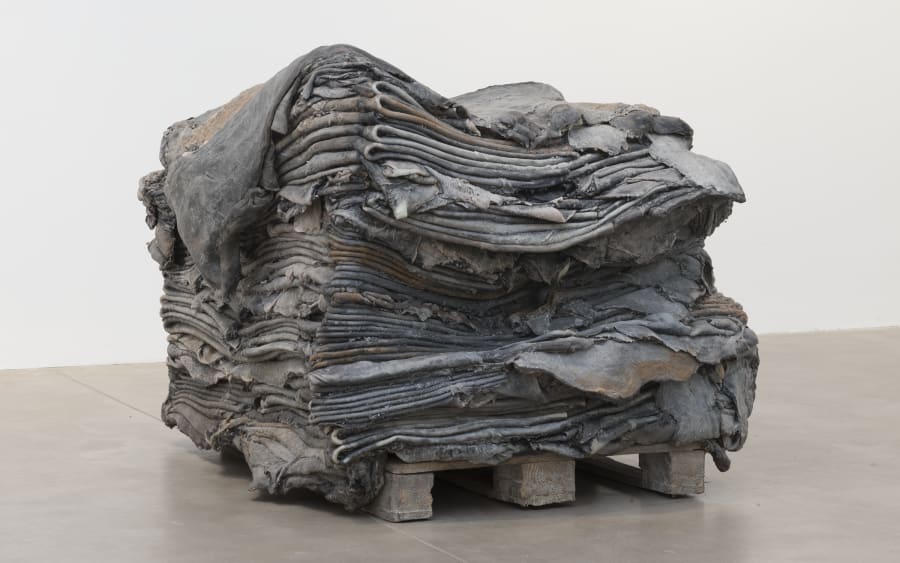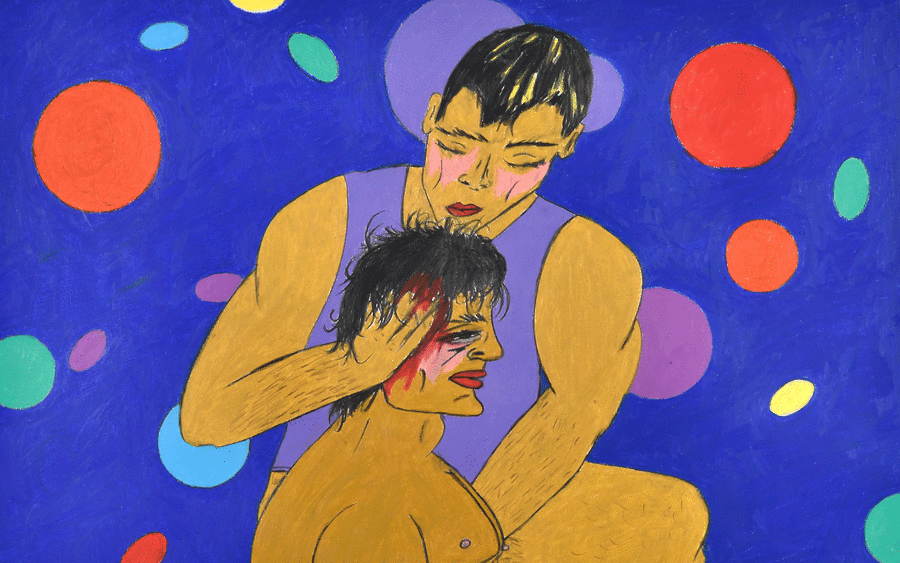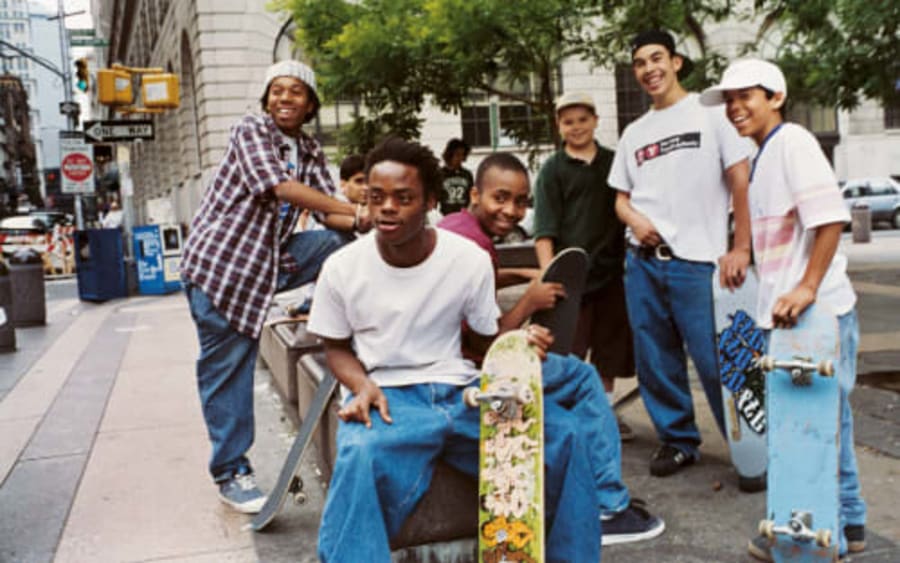From April 17 to November 24, 2024, the Museo Correr in Venice hosts the exhibition ‘Musei delle Lacrime’ (‘Museums of Tears’), conceived by Francesco Vezzoli (b. 1971, Brescia) and curated by Donatien Grau. The exhibition extends Vezzoli’s exploration of heritage which began nearly 30 years ago by embroidering tears onto iconic artworks. In a dialogue with the museum’s collection and architecture – including a section renovated in the 1950s by legendary Italian architect Carlo Scarpa – he now presents a series of works spanning two decades, including a dozen newly conceived artworks. To mark the exhibition’s opening, Vezzoli and Grau delve into their creative and collaborative process.
Donatien Grau: I met you, Francesco, about 15 years ago. You were one of the first people who trusted me. I remember when you did the performance with Lady Gaga at MOCA [Museum of Contemporary Art] in Los Angeles, in 2009. You were also working on a book, and you immediately thought I should write the essay. I have no idea why, because I didn’t write essays for artists showing at galleries at the time, certainly not for performance-related projects. Since then, we’ve had this continuing conversation over the years. And now I feel I know you, I see where you stand and what you have achieved in ways you would not and could not formulate, because the very point of your ideological, artistic, political, and historical structure is a refusal of consolidation.
Francesco Vezzoli: Today, Donatien, you are a close friend to me, with deep knowledge across various subjects, so I always value your insights. Our connection transcends the typical artist-curator dynamic; it’s more profound. When I feel lost, I turn to you, and you are always attuned to my needs. Our bond is genuine and significant. This may not be a scientific explanation, but it’s certainly sincere.
DG: When we first met, you embodied the epitome of glamour as an artist. What struck me most about you was, and still is, your unapologetic self-expression, as well as your ability to detach from yourself, which, for many, can be quite disconcerting qualities. You’re among the few artists who have challenged conventional artistic norms, not solely confined to matters of sexual identity, though that is indeed significant. Your work critiques existing paradigms and engages in a reevaluation of cultural roles and knowledge. I believe in the transformative power of artists as part of a longer transmission of art. Just as Derek Jarman influenced you profoundly, you, in turn, have played an important role in reshaping our understanding of art history over the past three decades. While some may label your work as kitsch or overly dramatic, I see it as a provocative challenge to our historical interpretations.
FV: I don’t harbor feelings of anger or animosity towards those who criticize me. But as you pointed out, there’s sometimes confusion or perhaps frustration with my decisions. Let me clarify. After spending about 25 years abroad, I made a conscious decision to embrace a more Italian lifestyle, which inevitably influenced my relationship with history and political identity. I’m now based in Italy, where opportunities and societal and political readings are unique. Unlike in countries like the US, UK, or France, where there’s a well-established art system, Italy lacks such a structured art industry. So, you’re faced with a choice: adapt to the limitations or redefine your professional boundaries to remain active. While this might occasionally ruffle feathers, it’s not intentional. I’m navigating the unique landscape of being an artist in my country, which lacks certain prominent figures and the diverse political and historical references found elsewhere. Because, you know, we don’t have, for better or worse, Roberta Smith, Jerry Saltz, Thelma Golden or Glenn Lowry. We don’t have all these kinds of points of different political historical references.
DG: I find the question of Italy particularly intriguing in your case. Italy has served as a political and cultural laboratory for the past 70 years. What’s intriguing about how you navigate your current situation is that it delves into subjects that are rooted yet remarkably open, connecting to various global perspectives beyond Italy. Additionally, it’s worth noting your specific background – you’re Italian, hailing from Brescia in the north, which carries its own unique identity. What’s fascinating is how your identity is deeply rooted in many aspects, yet you consistently challenge it. It seems that from a young age, you were compelled to confront your identity, shaping your work as a form of constructive criticism of your circumstances.
FV: I agree. To put it succinctly, while I’m not comparing myself to him, even though we live on the same street, consider Lucio Fontana’s era. In the period when Abstract Expressionism was gracing the cover of Time magazine and sparking fervent critical discussions, Fontana’s life revolved around more mundane activities like meeting legendary designer Gio Ponti to discuss villa decor in South America. Italy has always offered various structural dynamics, and one way or another, you must construct your identity around the opportunities presented; rejecting them isn’t feasible. Thus, this relationship with history becomes both a choice and a chosen commitment. It entails delving into the international discourse, reading pertinent literature, attending key exhibitions, and then discerning the contribution you can offer to the dialogue. Yet, as you reflect on your unique contribution, the backdrop of Italian history inevitably emerges as an inescapable element.
DG: There’s a unique aspect to art projects presented in Venice due to its nature as a city for foreigners. Venice historically stands at the intersection of Italy and the broader world. In this context, projects in Venice serve as a conduit between the past and the present, navigating the balance between tradition and contemporary influences.
FV: How can one not interpret the city itself as a political metaphor, almost certainly for Italy, if not for the world? At this moment in history, in Venice, per square kilometer, you’ll find the largest concentration of artistic institutions in the world, encompassing both public and private entities, including about five to six public institutions along with various private foundations and the Biennale. Thus, Venice is positioned to be a hub of debate on the contemporary era. Can I deviate from my usual style and claim responsibility and pride? I believe presenting this exhibition at Museo Correr, in a dialogue with the architecture by Carlo Scarpa and the history of art, is a form of political art. It’s akin to shining a spotlight on Venice as a political metaphor for contemporary culture. And if people come to Venice merely for a cocktail party, well, that’s their prerogative.
DG: Your work and thought process operate on different levels, with one layer complementing the other. So, no layer excludes the rest. You’ve adeptly played with spectacle, much like Carlo Scarpa did. However, you introduce a contradiction within that very spectacle. Part of our objective is to explore the various avenues through which we can widen the crack within the spectacle itself. Critique, as well as celebration, of the spectacle, are inherent within it. If we consider the spectacle as a rhetorical device, it serves as a means to convey messages, one that can be critiqued from within.
FV: The title of the exhibition is ‘Musei delle Lacrime’ (‘Museums of Tears’). I often find myself in a bit of a quandary when faced with questions about the act of crying in my artwork. It’s the one inquiry that tends to unsettle me. People not only inquire about the current presence of tears but also probe into the origin of tears in my earlier works, dating back to when I first started as an artist some 25 years ago. About a year ago, you, Donatien, pointed out to me something that seemed rather obvious in hindsight – that I have a melancholic disposition. I channeled this aspect of my personality into my art, particularly through the motif of tears. Now, if we were to approach this from a more academic standpoint, consider the scarcity of tears in the history of art. It’s quite striking. From the Louvre to the Uffizi, tears are rarely depicted, and even when they are, they’re often obscured or concealed.
In a sense, I’ve chosen to challenge this historical reluctance to portray tears openly. Just as certain artists gain renowned for their mastery of specific subjects, I aspire to be recognized as the ‘maestro delle lacrime,’ the master of tears. It’s my way of liberating this symbolically charged fluid within the realm of art history.
DG: It’s a great statement, embodying an immediate contradiction in terms, which is quintessentially you. Tears lack the expected monumentality associated with mastery, thus carrying a poignant irony. This interplay between the intimate and the monumental lies at the heart of your artistic vision. A tear, so ordinary and human, stands in stark contrast to the grandiose. In essence, what you’re accomplishing is a monument to intimacy. In your work, the tears serve as both individual expressions and universal symbols of loss. They epitomize the essence of loss – a feeling that transcends individual experiences. Yet, paradoxically, your work with loss and history creates space for new narratives to emerge. This tension between the intimate and the monumental forms the essence of your artistic endeavor. The upcoming exhibition at Museo Correr explores these themes in various ways, offering a captivating glimpse into the profound complexities of your work.
Francesco Vezzoli
‘Musei delle Lacrime’
Museo Correr, Venice
From April 17 to November 24, 2024
Donatien Grau is a philologist, editor, scholar, and museum executive, based in Paris. He is the Head of Contemporary Programs at the Louvre, the Chairman of the Association Pierre Guyotat, and the Editor-in-Chief and Artistic Director of the newly-founded magazine Alphabet.
Patrick Steffen is Editor, France at Art Basel. He is based in Paris.
Caption for top image: Francesco Vezzoli, La nascita di American Gigolò (After Sandro Botticelli) (detail), 2014.
Published on April 17, 2024.


